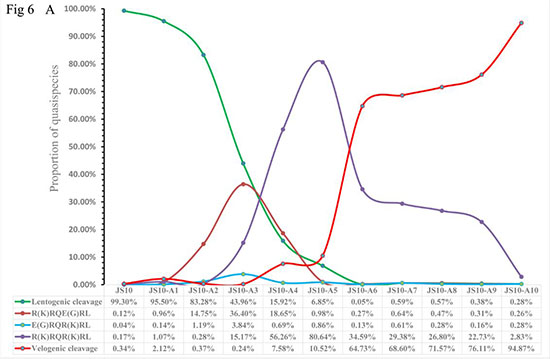分享到
SHVRI researchers identify a novel mechanism for virulence evolution of Newcastle Disease Virus
Recently, the Waterfowl viral infectious diseases innovation research group led by professor Ding Chan at the Shanghai Veterinary Research Institute (SHVRI) of Chinese Academy of Agricultural Sciences (CAAS) identified quasispecies diversity as a novel mechanism of Newcastle Disease Virus (NDV) virulence enhancement. This finding is published in the Journal of Virology on Dec 9, 2015.


Phylogenetic analysis of NDV evolution showed that velogenic viruses likely emerged from a lentogenic progenitor virus via change two amino acids at the F0 cleavage site. The researchers passaged an avirulent isolate JS10 through chicken air sac and embryos, and the pathogenicity of the variants was assessed. A virulent variant, JS10-A10, was generated from consecutive passage in air sacs. And they developed a deep sequencing approach to detect of low-frequency viral variants across the NDV genome and observed that virulence enhancement of JS10 was due to the selective accumulation of velogenic quasispecies and the concomitant disappearance of lentogenic quasispecies. Their results suggest that because it is difficult to avoid contact between natural waterfowl reservoirs and sensitive poultry operations, circulating lentogenic NDV strains may represent a potential reservoir for emergent velogenic NDV strains that could cause outbreaks in chickens.
Latest News
-
 Apr 18, 2024Opening Ceremony of the Training Workshop on Wheat Head Scab Resistance Breeding and Pest Control in Africa Held in CAAS
Apr 18, 2024Opening Ceremony of the Training Workshop on Wheat Head Scab Resistance Breeding and Pest Control in Africa Held in CAAS -
 Apr 03, 2024IPPCAAS Co-organized the Training Workshop on Management and Application of Biopesticides in Nepal
Apr 03, 2024IPPCAAS Co-organized the Training Workshop on Management and Application of Biopesticides in Nepal -
 Mar 28, 2024Delegation from the School of Agriculture and Food Science of University College Dublin, Ireland Visit to IAS, CAAS
Mar 28, 2024Delegation from the School of Agriculture and Food Science of University College Dublin, Ireland Visit to IAS, CAAS -
 Mar 25, 2024Director of World Food Prize Foundation visited GSCAAS
Mar 25, 2024Director of World Food Prize Foundation visited GSCAAS -
 Mar 20, 2024Institute of Crop Sciences (ICS) and Syngenta Group Global Seeds Advance Collaborative Research in the Seed Industry
Mar 20, 2024Institute of Crop Sciences (ICS) and Syngenta Group Global Seeds Advance Collaborative Research in the Seed Industry
